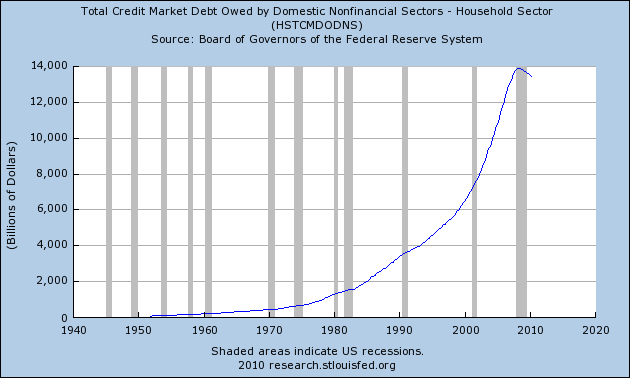U.S. Household Debt
Jump to navigation
Jump to search
A U.S. Household Debt is a household debt held by a U.S. household.
- Context:
- It can be associated to a U.S. Personal Debt w.r.t. GDP or U.S. per Capita Personal Debt.
- It can range from being a Total U.S. Personal Debt to being a Net U.S. Personal Debt.
- It can range from being a Internally-Held U.S. Personal Debt to being a Externally-Held U.S. Personal Debt.
- It is a component of US per Capita Household Debt.
- It is a component of US Debt (along with US Government Debt.
- It can include a U.S. Household Mortgage Debt.
- Example(s):
- a U.S. Personal Debt of 1940.
- a U.S. Personal Debt of 2017-02-12, of ~$18,848,539,000,000 (~$57,602 per capita).
- …
- Counter-Example(s):
- Japanese Personal Debt, Canadian Personal Debt, German Personal Debt, ...
- U.S. National Debt, such as ~$20,628,595,900,000 on 2018-02-11 (or ~$63,000 per capita).
- U.S. Personal Savings Rate.
- U.S. Household Wealth.
- U.S. per Capita GDP.
- U.S. Gini Index.
- U.S. Health Care Spending.
- U.S. Consumer Debt.
- See: United States Treasury, Budget Balance.
References
- http://www.usdebtclock.org/
- https://research.stlouisfed.org/fred2/graph/?graph_id=113589&category_id=7519
- http://research.stlouisfed.org/fred2/graph/?graph_id=113589&category_id=7519
- http://research.stlouisfed.org/fred2/graph/?graph_id=136424&category_id=7519
- https://fred.stlouisfed.org/series/CMDEBT
2019b
- https://www.washingtonpost.com/business/2019/02/12/record-million-americans-are-months-behind-their-car-payments-red-flag-economy/?utm_term=.3eb1a23f873f
- QUOTE: A record 7 million Americans are 90 days or more behind on their auto loan payments, the Federal Reserve Bank of New York reported Tuesday, even more than during the wake of the financial crisis. Economists warn that this is a red flag. Despite the strong economy and low unemployment rate, many Americans are struggling to pay their bills. ...
2019c
- (2019). “Total Household Debt Rises as 2018 Marks the Ninth Year of Annual Growth in New Auto Loans - Auto Loan Balances Continue Rising; Younger Borrowers Struggle With Auto Debt Delinquencies."
- QUOTE: ... Total household debt increased by $32 billion (0.2%) to $13.54 trillion in the fourth quarter of 2018. It was the 18th consecutive quarter with an increase and the total is now $869 billion higher than the previous peak of $12.68 trillion in the third quarter of 2008. Furthermore, overall household debt is now 21.4% above the post-financial-crisis trough reached during the second quarter of 2013. The Report is based on data from the New York Fed’s Consumer Credit Panel, a nationally representative sample of individual- and household-level debt and credit records drawn from anonymized Equifax credit data. ...
2014
- http://en.wikipedia.org/wiki/Household_debt#United_States_household_debt_statistics
- U.S. household (HH) debt (measured by the FRED variable "CMDEBT")[1] rose relative to both GDP and disposable income over the 1980 to 2011 period.
- Household debt as a % disposable income rose from 68% in 1980 to a peak of 128% in 2007, prior to dropping to 112% by 2011.
- Household debt as a % nominal GDP rose from 47% in 1980 to a peak of 94% in 2009, prior to dropping to 77% in 2012.[2]
- U.S. household debt rose from nearly zero in the 1950s to $13.8 trillion in 2008, before declining to $12.9 trillion by Q2 2012.[3]
- Consumer credit outstanding includes credit cards, auto loans, student loans, and other types of household debt, but excludes mortgages. It rose from 14.0% GDP in January 1990 to 18.0% GDP by January 2009. It fell to a trough of 16.4% GDP in July 2010 and was back up to 17.5% GDP by January 2013.[4]
- U.S. household (HH) debt (measured by the FRED variable "CMDEBT")[1] rose relative to both GDP and disposable income over the 1980 to 2011 period.
2010
2009
- "America’s Debt Overhang: Growth or Austerity, and other Policy Choices." http://www.newamerica.net/files/9-15-09_Debt_Overhang.pdf
2007
- (Dynan & Kohn, 2007) ⇒ Karen Dynan, and Donald Kohn. (2007). “The Rise in US Household Indebtedness: Causes and Consequences." FEDS Working Paper.
2000
- (Sullivan et al., 2000) ⇒ Teresa A. Sullivan, Elizabeth Warren, and Jay Lawrence Westbrook. (2000). “The Fragile Middle Class: Americans in debt." Yale University Press. ISBN:0300091710
